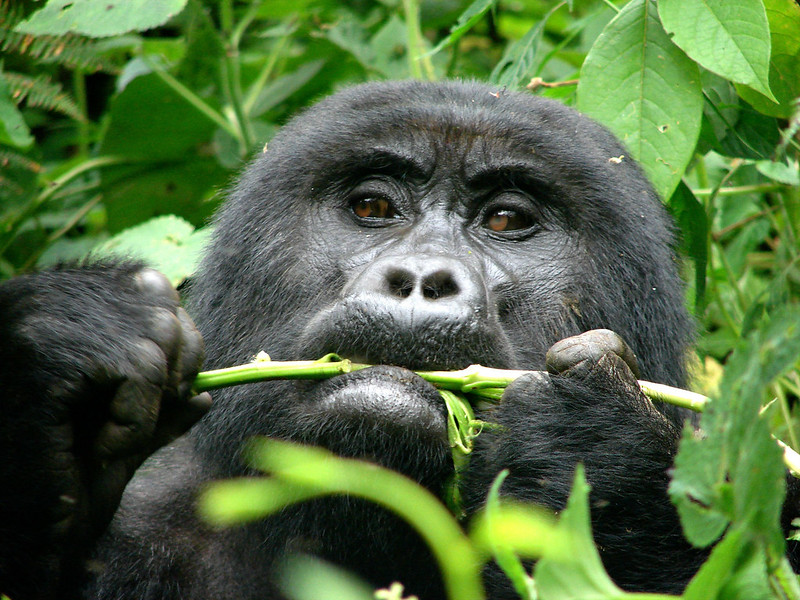What DO Gorillas Eat
What do Gorillas Eat? The proximity of mountain gorillas to humans and their endangered state raises questions about their diet and the factors contributing to their strength. Their inability to thrive in zoo captivity is another reason why individuals inquire about the dietary habits of mountain gorillas. The food of mountain gorillas primarily consists of plant material, including leaves, stems, buds, piths, and barks. The dietary habits of gorillas fluctuate according to the food availability in their area, as their environment lacks an abundance of fruit. Due to their habitation in high-altitude regions, mountain gorillas have limited access to fruit trees, resulting in fruits constituting a minor portion of their overall diet.
Over 85% of a mountain gorilla’s diet comprises leaves, stems, buds, and seeds from over 140 consumable plant species within its natural habitat. The remainder of the diet consists of flowers, roots, and invertebrates. Mountain gorillas infrequently consume water to augment their diet. This is due to the substantial proportion of their diet consisting of fresh leaves that are already adequately hydrated. Due to their habitation in high-altitude regions, temperatures are low, and a gorilla’s physiology minimizes heat loss through perspiration.
The Mountain Gorillas inhabit the Virunga Mountains, Bwindi Impenetrable National Park, and the lowland regions of Kahuzi-Biega National Park, where they coexist with herbivores. As the largest primate on Earth, they require substantial sustenance, primarily consisting of plant matter. Mountain gorillas are known to consume around 142 plant species, with leaves, shoots, and stems comprising over 86% of their diet. 7% of their diet consists of edible roots, 3% flowers, and 2% fruits. Due to their high-altitude habitat, mountain gorillas have limited access to fruit compared to lowland gorillas, whose diet predominantly consists of fruit. Mountain gorillas are known to occasionally consume ants, snails, and grubs, which constitute 2% of their diet.

What DO Gorillas Eat
Mountain gorillas are the largest and most powerful primates on the planet. They utilize their immense strength to dismantle vegetation to access the specific section of the plant they desire. Gorillas play a crucial role in their ecological niche; they exhibit selectivity and do not deplete all the flora in their feeding areas. They facilitate the regeneration of vegetation and are perpetually relocating from one location to another. Their feeding behavior facilitates rapid replenishment.
Mountain gorillas are discerning foragers, consuming various sections of diverse plants. For example, they may exclusively ingest the root of one plant, the stem of another, and the leaves and fruit of yet another.
How much do gorillas Eat
The adult mountain gorilla ingests approximately 20 kilograms of food each day. This is due to their substantial physiques that require increased sustenance to generate adequate energy. Mountain gorillas exhibit a fear of water and hence do not ingest it directly; nonetheless, the extremely succulent foliage they consume supplies the necessary hydration for their survival. Mountain gorillas are herbivorous, consuming leaves, stems, and buds that are low in energy content. This is why they must consume far more food to provide the necessary energy for survival. Due to the considerable size of the silverback gorilla—nearly double that of the adult female—it consumes a significantly greater quantity of food to provide the necessary energy.
A silverback gorilla consumes approximately 27 kg of food daily. An adult female mountain gorilla consumes approximately 20 kg of food daily. The variation in portion sizes is attributable to variances in body proportions and may differ among individual gorillas. Newly born gorilla infants are nursed by their mothers for a duration of 2.5 to 3 years. At approximately 6 months of age, infant gorillas commence independently consuming plant matter. By the age of eight, kids can completely consume all solid foods.
Eating habits of mountain gorillas.
Gorillas allocate a significant portion of their day to foraging for sustenance or consuming it. They depart from their nocturnal sleeping sites at dawn and traverse the forest in search of an appropriate location to engage in foraging and repose. The silverback gorilla leads the group to a location with sufficient food for all members to consume. Mountain gorillas consume food twice daily; once in the morning and once in the evening. During the interval between the two meals, adult gorillas will repose while the young engage in play with one another.
Gorillas do not excessively consume resources in one location prior to relocating to another. Their method of harvesting leaves, shoots, stems, buds, and roots for sustenance is highly sustainable and does not damage the flora they consume. An impressive illustration of this behavior is that a gorilla refrains from consuming the roots of the same plant whose leaves or buds it has just ingested, opting instead for the roots of a different, related species. Each family of mountain gorillas forages inside its designated ‘zone,’ and encroaching upon another group’s territory is uncommon and may provoke confrontations, as the silverback defends his family. Here are few popular species of flora consumed by mountain gorillas. The complete list comprises around 140 plant species.
- Teclea Nobilis – consumes both fruit and foliage
- Solanum – consumes foliage
- Symphonia – consumes foliage
- Rapanea melanophloeos – consumes leaves, fruit, and decaying wood.
- Desmodium repandum – folivore
- Olea capense — consumes both the foliage and the fruit
- Chrysophyllum consumes both fruits and decayed wood.
- Ganoderma, a type of fungus
Visitors who have the opportunity to trek mountain gorillas in Uganda or Rwanda are accompanied by local guides who elucidate the diverse roles and significance of the plants consumed by mountain gorillas. Certain plants possess medical properties beneficial to both gorillas and occasionally humans.
